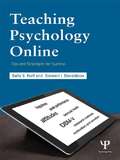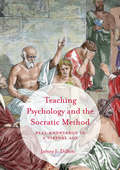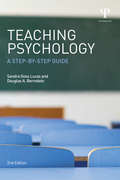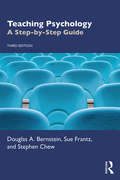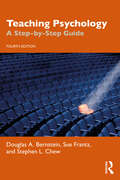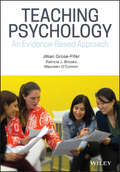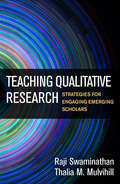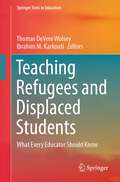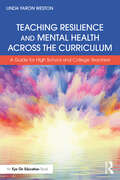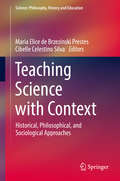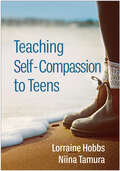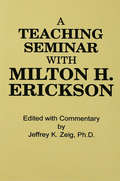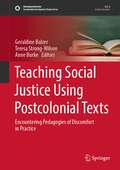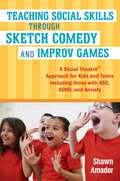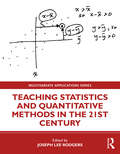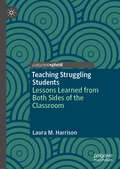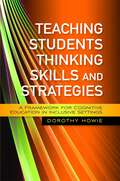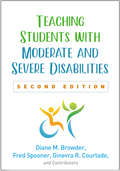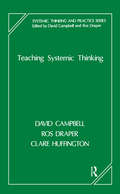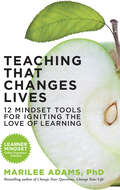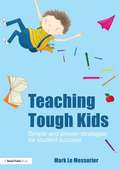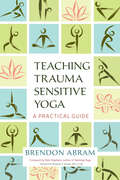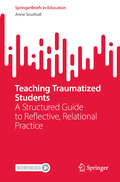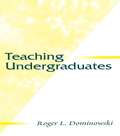- Table View
- List View
Teaching Psychology Online: Tips and Strategies for Success
by Stewart I. Donaldson Kelly S. NeffIntended as a resource for psychology educators ranging from teaching assistants to experienced faculty, this book shows readers how to effectively create and manage an online psychology course. Guidelines for preparing courses, facilitating communication, and assigning grades are provided along with activities and assessments geared specifically towards psychology. Pedagogical theories and research are fused with the authors’ teaching experiences to help maximize the reader’s abilities as an online psychology instructor. The book focuses on psychology education at the undergraduate level but it also includes material appropriate for graduate students and professionals. Readers will find helpful examples from all the major content areas including introductory, social, developmental, biological, abnormal, and positive psychology, and human sexuality. Every chapter is organized around 3 sections. The Purpose part introduces the key concepts, theory, and research. The Implementation section reviews the ‘nuts and bolts’ of online teaching, and the Troubleshooting section addresses key problems and potential solutions. 'Text boxes' highlight important tips. The website http://www.TeachingPsychologyOnline.com provides additional tips, links to related articles and other resources, and examples of online psychology assignments from across the discipline. The book addresses: launching your online course; enhancing student/instructor communication; modes of multimedia and how to integrate them into your course including lecture videos, podcasting, blogging, wikis, and social networking sites; creating activities for online courses; assessment and grading; and online education trend including doctoral level education. Ideal for instructors teaching ANY psychology course, from introductory to upper-level undergraduate to graduate courses, this text can be used for developing on line courses in applied areas such as counseling, health, and industrial psychology as well as for courses in social, cognitive, and developmental psychology. Instructors of any technical skill level can use this book, including those familiar with Blackboard to those who are just getting started. Whether you are a seasoned pro or new to teaching psychology online, the tips in this book can help improve your instruction, reduce your prep time, and enhance your students’ success.
Teaching Psychology and the Socratic Method
by James J. DillonThis book presents a lively and accessible way to use the ancient figure of Socrates to teach modern psychology that avoids the didactic lecture and sterile textbook. In the online age, is a living teacher even needed? What can college students learn face-to-face from a teacher they cannot learn anywhere else? The answer is what most teachers already seek to do: help students think critically, clearly define concepts, logically reason from premises to conclusions, engage in thoughtful and persuasive communication, and actively engage the franchise of democratic citizenship. But achieving these outcomes requires an intimate, interpersonal learning community. This book presents a plan for using the ancient figure of Socrates and his Method to realize humane learning outcomes in the context of psychology.
Teaching Psychology: A Step-By-Step Guide, Second Edition (Teaching Psychological Science Ser. #6)
by Douglas A. Bernstein Sandra Goss LucasThis volume provides thoroughly updated guidelines for preparing and teaching an entire course in psychology. Based on best principles and effective psychological and pedagogical research, it offers practical suggestions for planning a course, choosing teaching methods, integrating technology appropriately and effectively, developing student evaluation instruments and programs, and ideas for evaluation of your own teaching effectiveness. While research-based, this book was developed to be a basic outline of "what to do" when you teach. It is intended as a self-help guide for relatively inexperienced psychology teachers, whether graduate students or new faculty, but also as a core reading assignment for those who train psychology instructors. Experienced faculty who wish to hone their teaching skills will find the book useful, too.
Teaching Psychology: A Step-by-Step Guide
by Douglas A. Bernstein Stephen Chew Sue FrantzThis thoroughly revised third edition of Teaching Psychology synthesizes the latest pedagogical research on effective teaching and translates it into recommendations for classroom application. It also takes into account the many changes in the teaching landscape that have taken place in recent years. Covering key topics such as planning a course, choosing teaching methods, assimilating technology, and the integration of teaching into the rest of your academic life, this book also includes an abundance of supportive, supplementary content to guide and inform new teachers. This content will also benefit seasoned teachers who wish to reevaluate their current teaching practices and explore new teaching ideas and techniques. Presenting a comprehensive and cutting-edge teaching guide for psychology teachers, this book is a vital resource for those who are training psychology instructors or undertaking a teaching psychology course. It is also a useful text for more experienced faculty looking to update their current teaching practices.
Teaching Psychology: A Step-by-Step Guide
by Douglas A. Bernstein Sue Frantz Stephen L. ChewNow in its fourth edition, Teaching Psychology: A Step-By-Step Guide synthesizes the latest pedagogical research on effective teaching and translates it into recommendations for classroom application. It explores the rapidly changing academic landscape and offers innovative ideas for teaching psychology and creating inclusive classrooms where all students can experience a sense of belongingness and psychological safety.This comprehensive volume covers key topics such as planning a course, choosing teaching methods that promote well-being, diversity and inclusion, assimilating technology (including Artificial Intelligence), and the integration of teaching into the rest of your academic life. The authors include an abundance of supportive, supplementary content to guide and inform new teachers, including their own real-life anecdotes and examples. Fully revised throughout, this new edition analyses updated research on topics such as student evaluations of teaching, establishing the value of your courses, student motivation, and trigger warnings. This edition also features a completely new chapter on teaching psychology abroad and focuses on the goals of post-pandemic teaching, including harnessing the power of online and hybrid teaching environments.Presenting a valuable and cutting-edge guide for psychology teachers, this book is a vital resource for those who are training psychology instructors or undertaking a teaching psychology course. It is also a useful text for more experienced faculty who wish to reevaluate their current teaching practices and explore new teaching ideas and techniques.
Teaching Psychology: An Evidence-Based Approach
by Jillian Grose-Fifer Patricia J. Brooks Maureen O'ConnorA guide to an evidence-based approach for teaching college-level psychology courses Teaching Psychology offers an evidence-based, student-centered approach that is filled with suggestions, ideas, and practices for teaching college-level courses in ways that contribute to student success. The authors draw on current scientific studies of learning, memory, and development, with specific emphasis on classroom studies. The authors offer practical advice for applying scholarly research to teaching in ways that maximize student learning and personal growth. The authors endorse the use of backward course design, emphasizing the importance of identifying learning goals (encompassing skills and knowledge) and how to assess them, before developing the appropriate curriculum for achieving these goals. Recognizing the diversity of today's student population, this book offers guidance for culturally responsive, ethical teaching. The text explores techniques for teaching critical thinking, qualitative and quantitative reasoning, written and oral communication, information and technology literacy, and collaboration and teamwork. The authors explain how to envision the learning objectives teachers want their students to achieve and advise how to select assessments to evaluate if the learning objectives are being met. This important resource: Offers an evidence-based approach designed to help graduate students and new instructors embrace a student-centered approach to teaching; Contains a wealth of examples of effective student-centered teaching techniques; Surveys current findings from the Scholarship of Teaching and Learning; Draws on the American Psychological Association's five broad goals for the undergraduate Psychology major and shows how to help students build life-long skills; and, Introduces Universal Design for Learning as a framework to support diverse learners. Teaching Psychology offers an essential guide to evidence-based teaching and provides practical advice for becoming an effective teacher. This book is designed to help graduate students, new instructors, and those wanting to update their teaching methods. It is likely to be particularly useful for instructors in psychology and other social science disciplines.
Teaching Qualitative Research: Strategies for Engaging Emerging Scholars
by Raji Swaminathan Thalia M. MulvihillThis timely resource provides a framework for teaching students how to think qualitatively and become more critical and reflexive researchers. Presented are a wealth of pedagogical tools that instructors across the disciplines can tailor to their own needs, including thought-provoking discussion questions, group work exercises, and field activities. The authors discuss issues and choices in course design, including approaches to assessment and grading, and share sample syllabi for both online and face-to-face course formats. Exploring the complexities and debates that surround teaching qualitative research, the book argues for a holistic model of preparing novice researchers. It demonstrates effective ways to engage students in the qualitative inquiry process from start to finish--from understanding positionality and crafting a research problem to writing up findings for different audiences.
Teaching Refugees and Displaced Students: What Every Educator Should Know (Springer Texts in Education)
by Thomas DeVere Wolsey Ibrahim M. KarkoutiThis textbook serves as a guide for practitioners whose goal is to enhance refugee students’ learning experiences. With millions of children globally in refugee or seeking asylum status, this volume is a must-read for every 21st century educator. Often, refugee students have missed a substantial amount of schooling as a result of the disruptions in their home countries and transit through refugee camps. Others have never been to school at any time. Refugees enter school with the same hopes and aspirations as other students, but they also confront serious challenges.This textbook helps educators to restore hope through the following topics: empowering refugees in school liberating structures in resettlement camps increasing opportunity at university designing compassionate pedagogies leveraging technology connecting the community Each chapter includes points to ponder as educators work to apply the principles of restoring hope for refugee students and their families. This textbook also provides practical suggestions and case studies that will help educators to put theory into practice. Teachers and professors who are passionate about honing their skills will find this book a comprehensive resource when displaced students enter their classrooms. This volume will also be of great interest to teacher-educators, pre-service teachers, educators serving in refugee camps and school administrators.
Teaching Resilience and Mental Health Across the Curriculum: A Guide for High School and College Teachers
by Linda Yaron WestonWritten by a teacher for teachers, Teaching Resilience and Mental Health Across the Curriculum is an integrative approach to pedagogy for educators at the high school and college level to survive, thrive, and sustain in the profession. Blending theory, research, and practice for a comprehensive program for teachers to incorporate well-being tools into the classroom, each of the book’s five foundations includes engaging information, strategies, real-world examples, interactive reflection questions, and activities that can be directly applied to teaching and life. Practical guidance in designing real-world curriculum is offered alongside accessible strategies for engagement, investment, and active learning in student-centered classrooms. An essential guide for teachers, it includes techniques for incorporating well-being that are grounded in culturally responsive teaching, trauma-informed instruction, mental health, resilience, and emotional literacy. Teachers will also gain insight on how to make the career sustainable through practices for self-compassion and authentic self-care so they can not only survive, but flourish in and out of school. For all the challenges that students and teachers face, this book defines what it means, and what it takes, to teach in today’s classrooms.
Teaching Science with Context: Historical, Philosophical, and Sociological Approaches (Science: Philosophy, History and Education)
by Maria Elice Prestes Cibelle Celestino SilvaThis book offers a comprehensive overview of research at interface between History, Philosophy and Sociology of Science (HPSS) and Science Teaching in Ibero-America. It contributes to research on contextualization of science for students, teachers and researchers, and explains how to use different episodes of history of science or different themes of philosophy of science in regular science classes through diverse pedagogical approaches.The chapters in this book discuss a wide range of topics under different methodological, epistemological and didactic approaches, reflecting the richness of research developed in Spanish and Portuguese speaking countries, Latin America, Spain and Portugal. The book contains chapters about historical events, topics of philosophy and sociology of science, nature of science, applications of HPSS in the classroom, instructional materials for students and teacher training courses and curriculum.
Teaching Self-Compassion to Teens
by Lorraine Hobbs Niina TamuraGrounded in knowledge about the unique developmental challenges of adolescence, this book presents an innovative approach for teaching self-compassion to teens and young adults in clinical, educational, or community settings. Lorraine Hobbs and Niina Tamura provide guided practices, creative exercises, and teaching strategies adapted from Kristin Neff and Christopher Germer&’s widely disseminated Mindful Self-Compassion program for adults. Case examples, sample dialogues, and scripts illustrate how to set up and run successful groups that address teen concerns such as self-criticism, self-esteem, social comparison, and strong emotions. The book offers guidelines for cultivating a personal practice and working with parents. Tips for providing a safe, effective learning environment are woven throughout; a special chapter covers trauma-sensitive teaching.
Teaching Seminar With Milton H. Erickson
by Jeffrey K. ZeigFirst Published in 1985. Routledge is an imprint of Taylor & Francis, an informa company.
Teaching Social Justice Using Postcolonial Texts: Encountering Pedagogies of Discomfort in Practice (Sustainable Development Goals Series)
by Teresa Strong-Wilson Geraldine Balzer Anne BurkeThis book explores how teachers can re-examine their emotional investments in enacting dominant settler values through changing their text selection and teaching practices. Based on a longitudinal qualitative research study conducted by a national team of literacy scholars in collaboration with practicing literacy teachers at eight sites across Canada, the book investigates how groups of teachers, working collaboratively in inquiry groups, develop and implement curriculum to promote their own and their students’ understandings of social justice in postcolonial and settler spaces. In particular, the book highlights the rich and dynamic landscape of postcolonial authors, illustrators and texts, the development of culturally- sensitive curricula, and critical pedagogies possible in addressing contemporary and historical issues, both local and global. This book is primarily of interest to literacy scholars, literacy instructors (teacher educators) in teacher education programs, educational leaders, practicing teachers from the K-12 spectrum, and school district staff and policy makers with responsibilities for or interests in the potential of literacy and literature engagement for social justice education. The book is also be of interest to postsecondary educators and teacher educators wishing to use literature in social justice, anti-racist, and anti-oppressive courses.
Teaching Social Skills Through Sketch Comedy and Improv Games: A Social Theatre® Approach For Kids And Teens Including Those With Asd, Adhd, And Anxiety
by Shawn AmadorIntroducing a Social Theatre™, this book provides guidance on how to deliver fun and transformative activities to develop social skills in teenagers and children. Drawing on ideas from Social Thinking®, CBT, mindfulness and assertiveness training this book develops games, skits and short plays which can be adapted to suit children and teenagers including those who are gifted, typical, and those with mild to moderate cognitive abilities. These activities will help participants become more assertive and flexible as well as improving confidence, focus and self-esteem. Social Theatre™ can be used in small groups, in class or throughout the school, as well as in group therapy sessions. It provides a new and inclusive way to teach social skills and collaborative learning and is especially useful for those with anxiety, ADHD and ASD.
Teaching Statistics and Quantitative Methods in the 21st Century (Multivariate Applications Series)
by Joseph Lee RodgersThis work, which provides a guide for revising and expanding statistical and quantitative methods pedagogy, is useful for novice and seasoned instructors at both undergraduate and graduate levels, inspiring them to use transformative approaches to train students as future researchers. Is it time for a radical revision in our pedagogical orientation? How are we currently teaching introductory statistics and quantitative methods, and how should we teach them? What innovations are used, what is in development? This ground-breaking edited volume addresses these questions and more, providing cutting-edge guidance from highly accomplished teachers. Many current textbooks and syllabi differ in only superficial ways from those used 50 years ago, yet the field of quantitative methods—and its relationship to the research enterprise—has expanded in many important ways. A philosophical axiom underlying this book is that introductory teaching should prepare students to potentially enter more advanced quantitative methods training and ultimately to become accomplished researchers. The reader is introduced to classroom innovation, and to both pragmatic and philosophical challenges to the status quo, motivating a broad revolution in how introductory statistics and quantitative methods are taught. Designed to update and renovate statistical pedagogy, this material will stimulate students, new instructors, and experienced teachers.
Teaching Struggling Students: Lessons Learned from Both Sides of the Classroom
by Laura M. HarrisonThis book tackles the phenomenon of limited learning on campuses by approaching it from the point of view of the author, an educator who writes about the experience of being, simultaneously, a college student and a college professor. The author lays out her experience as a student struggling in an introductory linguistics class, framing her struggles as sites ripe for autoethnographic interrogation. Throughout the book, the author melds her personal narratives with the extant research on college student learning, college readiness, and the interconnectedness of affect, intellect, and socio-cultural contexts. This book poses a challenge to the current binary metanarrative that circles the college student learning conundrum, which highlights either the faculty or student perspective, and unfolds this unnecessary binary into a rich, nuanced, and polyvocal set of perspectives.
Teaching Students Thinking Skills and Strategies: A Framework for Cognitive Education in Inclusive Settings
by Dorothy HowieDeveloping the ability to think is a major part of education, which helps students become independent learners and participate fully in a learning environment. This book sets out the theory and outlines a model for implementing the teaching of thinking at whole-school, group and individual levels in inclusive settings. The model uses a three-tier approach to ensure that all learners are included: teaching thinking for all, which takes into account common needs; working with small groups, for those with exceptional needs such as learning difficulties or high ability; and addressing individualised learning needs, including those with a complex disability. The book covers key approaches to the teaching of thinking, giving examples of how each can best be used at each tier level. It also addresses the impact of different social contexts, cultures and environmental surroundings on learning. This book will be essential reading for all members of school communities, including education leaders and teachers. Educational psychologists, special educational needs co-ordinators, speech and language therapists, and those with particular interest in educating children who are vulnerable, from disadvantaged backgrounds, and from culturally different backgrounds, will find much of value in this book.
Teaching Students with Moderate and Severe Disabilities, Second Edition
by Diane M. Browder Fred Spooner Ginevra R. Courtade and ContributorsFor years the text of choice for developing excellence as a teacher of K–12 students with moderate and severe disabilities, this clearly written work has now been revised and updated. Chapters provide step-by-step procedures for designing standards-based individualized education plans and evaluating and enhancing student progress. Methods and materials for teaching literacy, mathematics, science, and social studies are described in depth. The book also describes effective ways to build functional daily living skills. User-friendly features include extensive vignettes and classroom examples, end-of-chapter application exercises, and reproducible planning and assessment tools. Purchasers get access to a Web page where they can download and print the reproducible materials in a convenient 8 1/2" x 11" size. New to This Edition *Reflects important advances in research and evidence-based practice. *Chapter on collaborating with culturally diverse families, plus a stronger multicultural focus throughout. *Chapter on writing instruction. *Two additional chapters on reading and math, ensuring coverage of both foundational and grade-aligned skills. *Increased attention to students with autism spectrum disorder and to uses of technology.
Teaching Systemic Thinking (The Systemic Thinking and Practice Series)
by David Campbell Ros Draper Clare HuffingtonTherapists recognise that the practice of systemic family therapy is as much about the way one thinks as it is about what one does, and this book was the first in this field to address specific ways of teaching people to think sytemically. It discusses the way people learn; the components of a successful teaching event; and many exercises which have proven helpful in changing the way people think. The book is based on seminars and courses given by the author over a twelve year period, and it is clearly and methodically written so the reader can easily apply the exercises to their own practice and teaching. Since systemic thinking is a growing field being applied to many different areas of work, this book has been enjoyed by a wide readership of people who work with families as well as large and small organisations.
Teaching That Changes Lives: 12 Mindset Tools for Igniting the Love of Learning
by Marilee G. AdamsBuilding on the success of her classic, bestselling book, Change Your Questions, Change Your Life, Marilee Adams shows how, by adopting a new mindset, teachers can rekindle their love of teaching and ignite their students with a love of learning.Teaching That Changes Lives is a transformational and practical guide that will enable teachers to make an authentic difference with their students and avoid succumbing to the myriad pressures and challenges of their jobs. Using the storytelling format that proved so successful in her previous book, Adams tells how Emma, a sixth-grade teacher on the verge of quitting her job, learns to cultivate what Adams calls the “Learner Mindset”— having the discipline, curiosity, and courage to consistently ask growth-oriented, open-minded questions of oneself and others—and to avoid the close-minded and critical “Judger Mindset.” Emma transforms her classroom, her relationships with her colleagues, and, most importantly, her students' eagerness for learning and achievement. Teaching is more than imparting facts and skills—it's preparing students for the test of life. Featuring an innovative, easy-to-follow workbook and access to a Learner Mindset online mini-course, this inspiring book will ensure that teachers and students alike become creative, resilient problem solvers, bridge builders, and lifelong learners.
Teaching Thinking: Issues and Approaches (Psychology Library Editions: Cognitive Science)
by Robert J. Swartz D.N. PerkinsOriginally published in 1990, this title attempts to provide for the educational practitioner an overview of a field that responded in the 1980s to a major educational agenda. This innovative ‘agenda’ called for teaching students in ways that dramatically improved the quality of their thinking. Its context is a variety of changes in education that brought the explicit teaching of thinking to the consciousness of more and more teachers and administrators.
Teaching Tough Kids: Simple and Proven Strategies for Student Success
by Mark Le MessurierHow can you really make a difference for your students? Teaching Tough Kids delivers a refreshing collection of realistic ideas to sustain the organisational and behavioural transformations of all students, particularly those who 'do it tough'; who learn and react differently. They are complex kids who find life tougher than most. Managing their emotion and behaviour presents educators with a spectacular challenge in schools today, and numbers are on the rise. Filled with inspirational case studies, this book focuses on building improved relationships, structures and behaviours, rather than seeing the student as 'the problem' that must be fixed. Highlighting the value of promoting positive connections with students of all ages, the author presents ways to incorporate inclusive ideas into everyday practice and construct pathways for students to become engaged in their learning and achieve success. This stimulating book shows teachers how to: build student connectedness to learning; set achievable goals for each individual child; support emotional stability; strengthen organisation patterns; address behavioural issues; improve homework planning; create friendships and deal with bullying. Teaching Tough Kids takes a particularly close focus on students identified with Learning Disability, Attention Deficit Disorder, Attention Deficit Hyperactivity Disorder, Oppositional Defiant Disorder and Asperger Syndrome. Another group of students with executive functioning difficulties are emerging in schools. These are the kids who have endured neglect or too much stress and uncertainty in their lives and as a result display classic symptoms of hyperactivity, hyper vigilance and impulsivity. Teaching Tough Kids will be of immense interest to teachers, student teachers, staff in Pupil Referral Units, SENCos and all those involved with Behaviour Support work.
Teaching Trauma-Sensitive Yoga: A Practical Guide
by Mark Stephens Brendon Abram Margaret A. HowardA practical, hands-on, experienced-based guide from a military veteran turned yoga teacherBrendon Abram combines his first-hand experience with PTSD in the field and years of teaching to offer this practical guide to bringing trauma-sensitive yoga to both clinical and studio settings. Drawing on his work with military veterans, first responders, and survivors of domestic and sexual abuse, he emphasizes the importance of respecting the uniqueness of every individual and demonstrates how to use the foundational principles of yoga to create a safe experience. Abram explains that basic principles of yoga bring power to the practice and that breath, mindful movement, focused awareness, and acceptance of present-moment experience form the foundation of any yoga offering.
Teaching Traumatized Students: A Structured Guide to Reflective, Relational Practice (SpringerBriefs in Education)
by Anne SouthallThis book details an individualised approach to teaching traumatised students. While being trauma informed is an approach gaining interest in the field of education, frameworks that can respond to the individual nature of traumatic experience and explicitly describe responses that open pathways for learning remain a gap in the literature. This book describes a three-phase pedagogical framework to develop the relational and self-regulatory capacity of the student as a prerequisite for learning. It presents a staged approach which directs deep analysis and in-depth understanding of the impact of trauma for each student in their own school and classroom context. This book takes teachers through a step-by-step process which draws on current neuroscience and educator experience, to design intervention strategies that mitigate the impact of early childhood trauma on learning.
Teaching Undergraduates (Educational Psychology Series)
by Roger L. DominowskiThis practical guide is designed to help college teachers plan their undergraduate courses and deliver high-quality instruction. The book's theme is that teaching is a creative, decision-making, idea-testing enterprise whose purpose is to facilitate student learning in all of its facets. Its goal is to help instructors understand the multiple kinds of learning taking place in their courses so that they can select, devise, evaluate, and modify teaching techniques to improve their effectiveness. Based on research on human learning, memory, thinking, and problem solving, as well as studies of teaching and less-formal reports of teaching practices, the book offers concrete advice about all aspects of college teaching. *Part I is devoted to course planning. It outlines the many decisions instructors face in defining a course as their own and discusses the larger issues that shape a course and constrain some specific choices. Selecting course content, choosing learning goals, deciding how to pace a course, and scheduling tests are some of these issues. A workable timetable for preparing a course is included. *Part II is a mini-course on human learning, memory, and thinking. It provides the conceptual foundation for making teaching decisions, for selecting instructional strategies, and especially for inventing new techniques that might particularly fit a specific course. *Part III deals with the "nitty-gritty" of college teaching, including how to choose a textbook; lecturing and conducting classroom discussions; types and purposes of writing assignments, and how to structure and evaluate them; dealing with plagiarism; strengths and weaknesses of different types of tests, the relation of tests to learning goals, and guidelines for constructing good tests; and grading systems. *Part IV addresses professional and ethical issues of importance and consequence to instructors. New college instructors, more experienced faculty who would like to reflect on their teaching practices and consider making some changes, and teaching assistants will all find this book relevant and useful.
